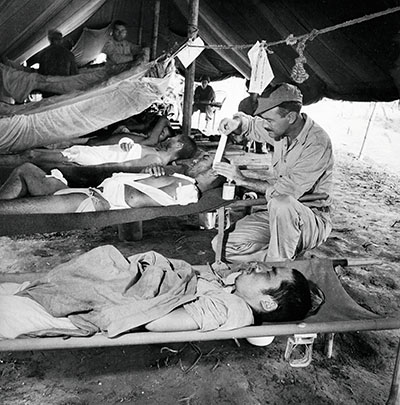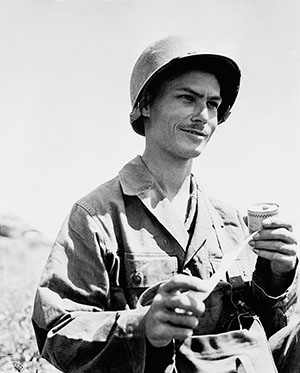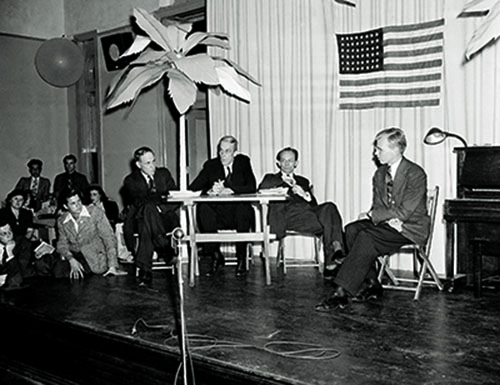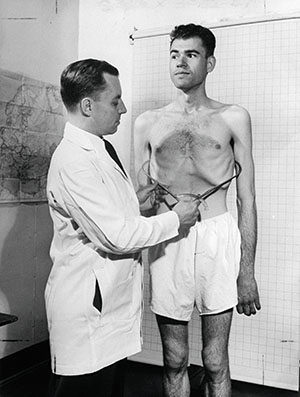From our 2015 Archives: Author Rachel S. Cox discusses Conscientious Objectors (COs) and the ways in which they served outside of the military while still adhering to their pacifist beliefs. They also include famous stars such as Hollywood actor Lew Ayres , blues legend Willie Dixon, and wartime hero Desmond T. Doss—the first CO to receive the Medal of Honor. Doss, a Seventh-day Adventist, went on to save fellow soldiers without killing a single person. The upcoming movie, Hackshaw Ridge, based on Doss’s life, will hit theaters on November 4.
[dropcap]J[/dropcap]APAN’S ATTACK on Pearl Harbor and America’s entry into the war galvanized the nation. Officially, domestic conflict over whether to fight resolved into the tempered elation of common purpose. “We are all in it—all the way,” FDR declared on December 9, 1941. “Every single man, woman, and child is a partner in the most tremendous undertaking of our American history.”
But not every American was a partner. Even when bright lines defined good and evil, freedom and repression, individuality and enslavement, some men refused to fight. By August 1945, nearly 70,000 Americans had declared that they “by reason of religious training and belief”—as the Selective Training and Service Act of 1940 put it—opposed war in any form. Although fully half these men still chose to serve their country through alternative service, that did not stop fellow Americans from damning conscientious objectors (COs) as draft dodgers or worse. Even FDR seemed to equate pacifism with cowardice. “There are some timid ones among us who say that we must preserve peace at any price,” he said in May 1941.
“What is the view that permits a man to accept safety instead of service in the midst of a war for survival?” asked New York Times writer Robert Van Gelder in a May 1942 magazine article. Van Gelder distinguished derisively between nonconformist religious pacifists and intellectuals opposing war on political and philosophical grounds. “In the one instance, some of the men can’t see the world as it is because their eyes are not sufficiently open,” Van Gelder wrote. “In the second instance a man can’t see the world as it is because he himself is in the way.”
Once the United States was at war, those unwilling to fight often bore the blame for the preceding years of vacillation. “The preachment and the practice of pacifists in Britain and America were a cause of the World War,” New York Herald Tribune columnist and World War I veteran Walter Lippmann wrote in August 1943. “They were the cause of the failure to keep pace with the growth of German and Japanese armaments. They led to the policy of…appeasement.”
Professing conscientious objection could cost a man his job. Louisiana barred state agencies from employing either COs or enemy aliens. New York Attorney General Thomas Dewey ruled that state workers registering as objectors had to enlist as noncombatants or be fired. Kentucky, Florida, and Ohio towns barred conscientious objectors from teaching in their schools.
Even sports heroes and matinee idols faced derision when they did not head for the barracks. Boston Red Sox star Ted Williams, wanting to see the 1942 season through, justified his 3A draft deferment by claiming to be his mother’s sole support. Skeptics sneered that Mrs. Williams and her notoriously peckish boy, 25, had not seen one another in two years. Williams joined the navy reserve and later became a flight instructor.

When in 1942 actor Lew Ayres, star of the 1930 antiwar epic All Quiet on the Western Front and the boffo Dr. Kildare franchise, declared himself a philosophical objector, the industry booed. Raged mogul Louis B. Mayer, “You’re through in Hollywood!” Theater owners boycotted Ayres’s films. The actor, who said bearing arms would cause him “to live in a nightmare of hypocrisy,” briefly worked at a camp for objectors in Oregon, then enlisted as an unarmed medic. “The most publicized CO in the country,” in historian Paul Fussell’s words, Ayres won three battle stars caring for soldiers and civilians under fire in New Guinea and the Philippines. Hollywood rehabilitated the actor, who donated his army pay to the American Red Cross.
To avoid derision, many men who had identified as pacifists in the 1920s and 1930s simply joined up. Others didn’t see themselves as having a choice. “To a real degree in 1941,” said Steve Cary, a World War II CO who went on to become the president of Haverford College in Pennsylvania, “you were a CO knowing that you didn’t have another answer.”
As an Amish objector told a filmmaker decades later, “World War II was a hard war to be a CO in.”
[dropcap]O[/dropcap]bjectors’ ranks were nearly as diverse as the army’s. Consider Robert Lowell, a Boston poet whose forebears arrived on the Mayflower and included a signer of the U.S. Constitution, and Willie Dixon, a slave’s grandson, ex-con, and former pugilist from Mississippi carving a career as a bassist and songwriter in Chicago.
Having withdrawn from Harvard at his psychiatrist’s urging and finished his degree at Kenyon College, Lowell was 26 when he received a draft notice in August 1943. As if declining a party invitation, he responded directly to President Roosevelt. “I very much regret that I must refuse the opportunity you offer me…for service in the Armed Force,” Lowell’s letter began. “You will understand how painful such a decision is for an American whose family traditions, like your own, have always found their fulfillment in maintaining, through responsible participation in both the civil and military services, our country’s freedom and honor.” Lowell believed that what had originated as a war for survival had devolved into a campaign to obliterate the people of Germany and Japan.
Dixon, imprisoned as a youth for “jumping trains”—hoboing—outside his native Vicksburg, was 21 when he migrated to Chicago to box—he was 6’6”, weighed 250 pounds, and sparred with Joe Louis—but quit the ring to sing the blues. Upon receiving an induction notice, Dixon declared that he felt no black man owed racist America national service. “Why should I go to work to fight to save somebody that’s killing me and my people?” he wrote in an autobiography. Police arrested him onstage mid-show.
Both landed behind bars—Lowell for a year and a day in New York City and in Danbury, Connecticut; Dixon, for 10 months in a Chicago jail—and they were not alone. Some 6,000 men did time for Selective Service Act violations; during the war, one man in six in an American prison was a draft resister. Roughly 1,600 “absolute resisters” refused to cooperate at all. The other 4,400 inmates were Jehovah’s Witnesses seeking exemption from military service not as COs but as ministers, requests the government denied.
Thousands more refused to fight but worked with the system. Dutiful resisters filed under Selective Service and Training Act Section 5(g), completing DSS 47, “Special Form for Conscientious Objectors.” Petitioners had to satisfy draft boards and sometimes appeals panels of their seriousness by answering 10 requests, starting with “Describe the nature of your belief which is the basis of your claim.” A man had to explain how he acquired his beliefs, give evidence and references, and answer the query, “Under what circumstances, if any, do you believe in the use of force?”

[dropcap]S[/dropcap]ome 27,000 men who were prepared to resist induction didn’t have to: they washed out after the physical. Of the rest, 25,000 opted for military duty as uniformed noncombatants, mostly in the Medical Corps. Desmond T. Doss, a Seventh-day Adventist from Lynchburg, Virginia, received the Congressional Medal of Honor for rescuing scores of wounded under fire on Okinawa while serving as a medic with the 77th Infantry Division.
Others wanted to work with the system but rejected noncombatant service on the grounds that filling a rear-echelon slot simply freed another man to kill. These objectors could serve in the Civilian Public Service, an alternative to military service that gave patriotic COs a chance to help their country outside of the armed forces.
Civilian Public Service arose from the country’s World War I experience with absolute draft resisters, who numbered fewer than 2,000 and who, according to Selective Service System director Clarence Dykstra, “presented difficulties…far out of proportion to the numbers involved.” Lacking an option during 1917 to 1918, the military posted objectors to army camps, presumably in hopes that in the company of other draftees men disinclined to combat might make themselves useful somehow or take up the gun after all. When “conchies” refused to follow orders, camp staff cut the men’s rations and stuck them in solitary, sometimes inflicting abuse tantamount to torture.
With this harsh history in mind, in the 1930s the Peace Churches—an umbrella term for the Society of Friends, Mennonites, and Church of the Brethren—collaborated with the American Civil Liberties Union, the War Resisters League, and the Fellowship of Reconciliation to seek reforms. About 58 percent of objectors had ties with the Peace Churches, and found in the commandment “Thou shalt not kill” a statement of purpose.
“No one could make me kill someone else,” William Anderson, who as a conscientious objector participated in a grueling starvation study, told a historian.
The Peace Churches wanted a civilian-run system, and would administer camps and support the resisters. Working with Congress, the War Department, and even President Roosevelt, they helped incorporate alternative service into the Selective Service and Training Act taking shape on Capitol Hill. The United States would not pay resisters for their service. (That last touch came to gall COs, especially since Uncle Sam paid German POWs held stateside 80 cents a day.)
Alternative service gained a key supporter when Brigadier General Lewis B. Hershey became Selective Service System director on July 31, 1941. A World War I veteran of Swiss Mennonite ancestry, Hershey had seen how forcing objectors into uniform did more harm wthan good. He believed in national service for all men but sympathized with the demands of conscience and the need to protect dissident minorities. Through the war he defended alternative service, which he called an experiment “to find out whether our democracy is big enough to preserve minority rights in a time of national emergency.”
The Civilian Public Service program dispersed COs among 152 work camps set in rural areas. In a variation on draftees’ progression once sworn in, program participants packed, bid loved ones farewell, and traveled far to live regimented lives cheek-by-jowl with fellow Americans of all kinds.
The first camp opened on May 15, 1941, at a disused Civilian Conservation Corps site outside Baltimore, Maryland. Residents planted trees and built campsites. More camps opened in response to Soil Conservation Service, Forest Service, and National Park Service requests for men to build firebreaks, roads, and trails, install and repair phone lines, and watch for forest fires. Crews of objectors worked for the Bureau of Reclamation building dams and fences, digging ditches, planting, and building irrigation systems. Wartime labor shortages broadened resisters’ options. By June 1943, 500 COs were working in agriculture as unpaid laborers. Others served as dairy testers and manned experiment stations.
Dispersing objectors reduced chances of conflict and made it harder for COs to publicize their views, but complaints still arose. “So why are these conscientious objectors with the jitterbug complex allowed to go out, drink, and publicly flount [sic] their draft status in front of hundreds of people who have dear ones in the Uniform of These United States?” the Lincoln County Times in Oregon editorialized.

COs encountered threats veiled and overt, were refused service at shops and restaurants, and got booted from vehicles by drivers who picked them up hitchhiking, asked why they were out of uniform, and bridled at the answer, sometimes turning around to try to run over the offending objector. “When I looked for jobs, they’d ask what my husband did,” said a woman whose spouse was serving at a camp in Southern California. “I was literally cursed and kicked out the door. I learned to say my husband worked for the Forest Service.” Vandals wrecked Peace Church offices. Objectors working on road crews got used to being shouted at. Some were shot at. Disgust for objectors turned self-destructive. A fire broke out in Plymouth, New Hampshire, near Civilian Public Service Camp 32, whose residents were trained firefighters. Townspeople let a third of Plymouth burn rather than ask COs to help.
[dropcap]Y[/dropcap]et objectors also encountered kindness or won over critics. In that same New England town, shaggy COs seeking a trim faced the notice, “No skunks allowed! So you conscientious objecters [sic] Keep to H— out of this Shop!” Vandals also tore down the camp sign. But rather than shy away, the COs attended church, sang in choirs, and worked with youth groups. The barber backed off, a replacement camp sign went undisturbed, and locals began inviting objectors into their homes.
Servicemen often showed more sympathy than civilians. Freedom of expression was, after all, one of the ideals for which men in uniform were fighting and dying. Objector Warren Sawyer’s most steadfast supporter was his brother, a Marine who enlisted the day after Pearl Harbor. And the hard time some public service men got may not have represented American sympathies at large. In a 1945 survey, four-fifths of respondents endorsed alternative service for conscientious objectors, while three-fourths believed COs deserved wages and dependency allowances.
[dropcap]O[/dropcap]BJECTORS EXPECTING to do something meaningful sometimes felt thwarted. Objector John H. Abbott told Studs Terkel in The Good War that the “work of national importance” the government promised objectors participating in the system felt more like “work of national impotence.” Men at some units organized work slowdowns and hunger strikes to support demands for pay, dependency allotments, and insurance coverage. Some men simply went absent without leave.
Other frustrated COs sought more satisfying projects. Hearing that the Forest Service was short of wilderness firefighters, Philip Stanley started Civilian Public Service Camp 103 in Missoula, Montana. Volunteers learned to parachute into wilderness blazes and, beginning in 1943, some 220 CO smokejumpers who spurned the front lines went onto the fire line. “It took a lot of gumption,” says historian Robert Cottrell. “No one should have accused them of being cowards.”
Beginning in March 1942, COs could satisfy the alternative service requirement by volunteering at hospitals and public health clinics. In Crestview, Florida, objectors screened windows in residents’ houses to fight malaria and improved sanitation to fight hookworm. In Puerto Rico, COs rebuilt a hospital surgery and prepared a medical index that identified parasites as the leading cause of disease.
Participants could join “guinea pig units” generating medical data useful to the war effort. At Indiana University, COs slept in cold rooms beneath wet sheets to illuminate the physiological effects of clothing in differing climates. A dehydration study volunteer drinking sea-water lost 16 pounds in less than a week. To study typhus, public service men in Campton, New Hampshire, donned lice-infested undershorts and tested insecticides by going weeks without changing their clothes or bedding. When researchers sought more lice fodder, most first-round volunteers re-upped.

COs took risks now outlawed, voluntarily undergoing infection with jaundice, malaria, atypical pneumonia, influenza, typhus, and hepatitis C. Some died. “I wanted to show that I was not a coward,” CO Neil Hartman, survivor of intentional hepatitis, said. “It fit right in with my scheme of things proving that I was willing to take risks on my own body, but I just did not want to kill someone else.”
With malnourished refugees and liberated POWs expected to number in the many thousands, University of Minnesota nutritionist Ancel Keys, father of the K ration, needed to learn how to feed them. The 36 participants he picked for his Minnesota Starvation Experiment from among 200 CO volunteers lived on about 1,500 calories a day and walked 45 miles a week. Once a man shed a quarter of his weight, he began to receive calibrated nutrition. A newspaper reported, “Army medical authorities who visited their barracks said their shrunken muscles and swollen joints give the men a striking resemblance to the prisoners freed from German concentration camps.” Study subject Max Kampelman, who went from 161 pounds to below 120, dreamed of candy bars and read cookbooks. “It is amazing what hunger can do,” he wrote in a memoir. “I never see a picture of famine victims without empathizing with the dehumanizing effects on the quality of their lives.”
COs profoundly affected care of mental patients. After six lonely months felling trees in North Carolina, objector Warren Sawyer wanted to work with people. He transferred to Pennsylvania State Hospital, a 6,000-patient facility for the mentally and physically impaired in Philadelphia that, like many asylums, needed staff. Byberry, the facility where Sawyer worked, was a cluster of firetraps. At each, brutal attendants herded 400 patients, many naked and incontinent, straitjacketed or strapped to beds, and given to fighting whoever was at hand. There and at 62 institutions nationwide, more than 3,000 CO volunteers strove to make life more peaceful. “We improved things just by the fact that we weren’t beating the patients,” Sawyer said. “Fighting lessened because the patients knew we would stop them without getting involved [in the violence].”
Objectors working at snake pits compared notes and documented what they saw. After objector Charles Lord surreptitiously took a camera into Byberry, his nightmarish black-and-white images found their way to Life magazine, which featured them in an article after the war. In “Bedlam 1946,” writer Albert Q. Maisel called American asylums “little more than concentration camps on the Belsen pattern.” The resulting outrage spurred reforms, and a new national organization launched by COs at Byberry, the National Mental Health Foundation, continued to obtain improvements in institutional mental health care after the war’s end.
[dropcap]M[/dropcap]ANY OBJECTORS hoped to do relief work overseas, but Congress forbade it. Mennonite Robert Kreider traveled to China expecting an assignment there only to have to turn back when the ban kicked in. Still, objectors’ efforts had a far-reaching influence. “The relief training units in several Civilian Public Service camps and hospital units encouraged many to consider postwar relief service,” said Kreider, who in February 1946 began what would be three years of relief work in Europe alongside fellow former COs. In 1947 the American Friends Service Committee won the Nobel Peace Prize for its aid programs.
In time, some ex-COs recanted. “I don’t think there was any other way to defeat Hitler,” said David Lyttle, a CO who worked at Byberry and later became a literature professor. Hiroshima and Nagasaki persuaded Max Kampelman that passive resistance was no alternative to war. He went on to negotiate arms control treaties with the Soviet Union.
Others, like Warren Sawyer, never looked back. After V-J Day, Sawyer turned in his draft card to President Truman, determined never to go to war.
“I’ve never had a day’s regret,” Sawyer, 93, said. ✯
This story was originally published in the March/April 2015 issue of World War II magazine. Subscribe here.





